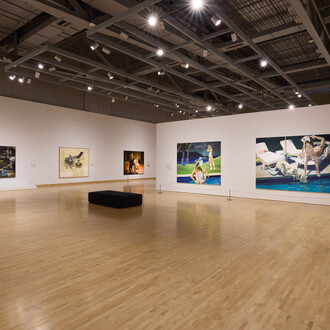Teotihuacan was the first, largest, and most influential metropolis on the American continent. In its heyday between 100 BCE and 650 CE, the city encompassed an area of 20 square kilometers with a population of more than 150,000. Both the inhabitants of Teotihuacan, its original name, and why the city was abandoned around 650 CE are still unknown. When the Aztecs, coming from the north in the first half of the 14th century, discovered its abandoned ruins on the Mexican Central Plateau, they named it Teotihuacan, the place where gods were born, and used it as the setting for their own creation myth.
Teotihuacan: City of Water, City of Fire is a major traveling exhibition organized by the de Young Museum in San Francisco in collaboration with the National Institute of Anthropology and History of Mexico. With more than 250 outstanding objects from the National Museum of Anthropology in Mexico City, as well as important objects borrowed from North American institutions, Teotihuacan: City of Water, City of Fire will provide a comprehensive insight into the art, everyday life, and religion of Teotihuacan, and its influence on other regions of Mexico. The exhibition will explore the archaeological history of the city through sculptures, friezes and murals; domestic objects including vessels and figures, stone carvings, masks, statues of gods and representations of animals; and extraordinary objects crafted out of precious materials including jade, obsidian, greenstone, and onyx.
Over the course of the exhibition, Phoenix Art Museum will partner with Arizona State University and its world-class archaeology faculty to create community-wide, all-ages programs to enhance visitors’ experience of these World Heritage archaeological treasures, on view for the first time in the state of A
![Eccentric, 200–250. Obsidian. Zona de Monumentos Arqueológicos de Teotihuacán / INAH [Acervo], 10-615741. Photograph by Jorge Pérez de Lara Elías, © INAH.](http://media.meer.com/attachments/ca56d6263a0a088ab215ba20a8841f64b5d3747a/store/fill/1090/613/4c8fd32c0b9d3f61f458c4dac08c47c9abb19210dd4fef9cd150334d5688/Eccentric-200-250-Obsidian-Zona-de-Monumentos-Arqueologicos-de-Teotihuacan-slash-INAH-Acervo-10.jpg)



![Standing figure, 200–250. Greenstone. Zona de Monumentos Arqueológicos de Teotihuacán / INAH [Proyecto Tlalocan]. Photograph by Jorge Pérez de Lara Elías, © INAH.](http://media.meer.com/attachments/80637ac04a5370e971619f92cf4cb50b64201792/store/fill/410/615/382f727c88edbd822dd0555362b55a64756bc1ce21c92583f78d89968590/Standing-figure-200-250-Greenstone-Zona-de-Monumentos-Arqueologicos-de-Teotihuacan-slash-INAH.jpg)









